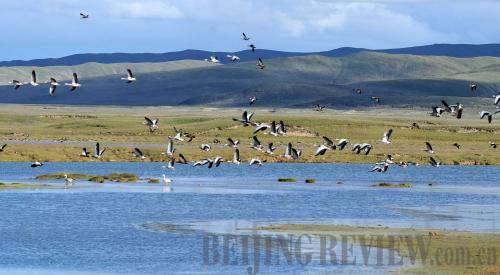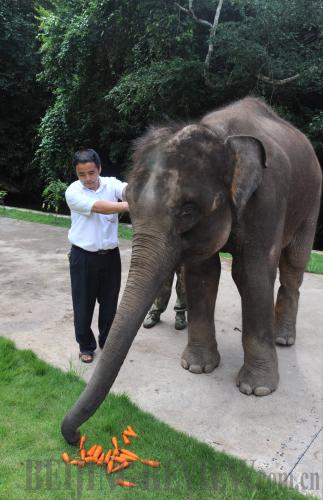|
 |
|
BEST HABITAT: Waterfowls take to the air in the Sanjiangyuan National Nature Reserve in Qinghai Province. The reserve is the origin of the Yangtze River, Yellow River and Lancang River (XINHUA) |
 |
|
PACHYDERM PRESERVE: A keeper feeds an elephant carrots at the Xishuangbanna Asian Elephant Breeding Center in Yunnan Province. The center is committed to protection, rescue and proliferation of Asian elephants (XINHUA) |
Bamei is located in Foshan Township, where Yunnan Province and Tibet Autonomous Region join. A survey in 2006 showed there were about 80 Yunnan snub-nosed monkeys in the mountains of Bamei, but the village was not covered by the established nature reserves. As a result, the local government and a number of nature conservation organizations jointly launched a special protection program. Through this program, the local government is striving to establish a community nature reserve in line with international practice, which will also provide opportunities for community development.
The recent forest carbon sequestration project, or ecosystem services project, has also brought new hope to poverty alleviation in areas around the reserves. Forest carbon sequestration refers to the plants' practice of absorbing carbon dioxide and fixing it in vegetation or soil, which will reduce the concentration of carbon dioxide in the air.
A carbon sequestration project centering on the forest is an important part of the Clean Development Mechanism (CDM), one of the "flexibility mechanisms" defined in the Kyoto Protocol that allows a country with an emission-reduction or emission-limitation commitment under the protocol to implement an emission-reduction project in developing countries. But, in the current framework of CDM, such projects are not being paid due attention.
The Copenhagen Climate Conference in 2009 put forest carbon sequestration into the blueprint of carbon trading in the United Nations Collaborative Program on Reducing Emissions from Deforestation and Forest Degradation in Developing Countries (REDD). Therefore, a sequestration project can bring in financial support for community nature reserves and also provide revenues for communities.
The IUCN calls for REDD to highlight the rights of indigenous residents in communities. And it proposes the establishment of community nature reserves as a policy plank.
| 